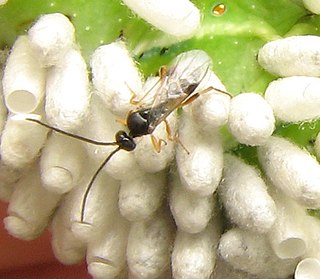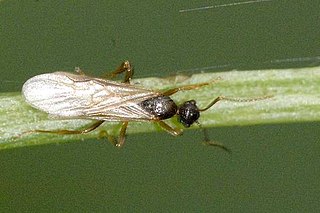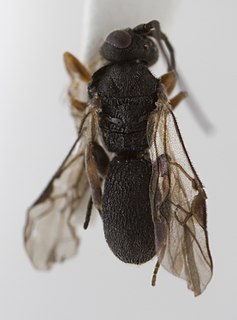
A polydnavirus (PDV) is a member of the family Polydnaviridae of insect viruses. There are currently 53 species in this family, divided among 2 genera. Polydnaviruses form a symbiotic relationship with parasitoid wasps, but these wasps are themselves parasitic on Lepidoptera. Little or no sequence homology exists between BV and IV, suggesting that the two genera evolved independently for a long time.

Cotesia congregata is a parasitoid wasp of the genus Cotesia. The genus is particularly noted for its use of polydnaviruses. Parasitoids are distinct from true parasites in that a parasitoid will ultimately kill its host or otherwise sterilize it.

Coelinidea elegans is a wasp species in the genus Coelinidea and the family Braconidae. It is found in Europe.
Calliscelio is a parasitoid wasp monotypic genus which contains one species, C. elegans. It was first described as Caloteleia elegans on Oahu in the Hawaiian Islands in 1910 by British entomologist Robert Cyril Layton Perkins, who believed it not to be an indigenous species of Hawaii. Its pantropical species distribution is now well-established and it is still considered to be an adventive species in Hawaii. C. elegans was reassigned from its original genus to Caenoteleia in 1926 by French entomologist Jean-Jacques Kieffer and then to Calliscelio in 2009.
Cheiloneurus elegans is a parasitic wasp species in the genus Cheiloneurus.
Bracovirus is a genus of viruses, in the family Polydnaviridae. Bracoviruses are an ancient symbiotic virus contained in parasitic braconid wasps that evolved off of the nudivirus about 190 million years ago and has been evolving at least 100 million years. It is one of two genera belonging to the Polydnaviridae family, Ichnovirus being the other genus. There are currently 32 species in this genus including the type species Cotesia melanoscela bracovirus.
C. elegans most commonly refers to the model round worm Caenorhabditis elegans. It may also refer to any of the species below. They are listed, first in taxonomic order and, second, alphabetically.
Cryptocheilus elegans is a species of spider wasp in the genus Cryptocheilus found in Europe.
Ceropales elegans is a spider wasp species in the genus Ceropales. It is found in Texas.
Calaphidius elegans is a species of braconid wasps in the subfamily Aphidiinae. It is found in Europe, including Germany, the Czech Republic and Finland.
Chrysolampus elegans is a species of chalcid wasps with a Nearctic distribution.

Chelonus is a wasp genus in the subfamily Cheloninae. Their larvae feed chiefly on larvae of moths in superfamilies Tortricoidea and Pyraloidea.
Callibracon elegans is a species of wasp in the family Braconidae.
Campyloneurus elegans is a species of wasp in the subfamily Braconinae. It is found in Cameroon.
Caenorhabditis inopinata - prior to 2017 referred to as C. sp. 34. - is a sister species to C. elegans.
Nemeritis elegans is a species of ichneumon wasps found in Europe.

Isodontia elegans is a species of thread-waisted wasp in the family Sphecidae that hunt orthopterans.
Steniolia elegans is a species of sand wasp in the family Crabronidae. It is found in Central America and North America.




